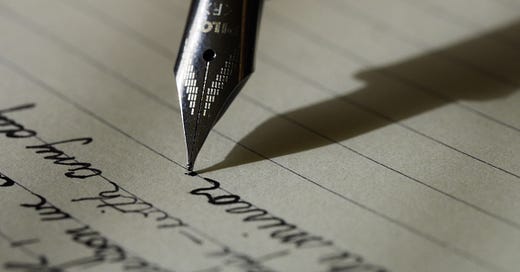New Year's Resolutions
How I'm taking a leaf out of Virginia Woolf's diaries as inspiration this new year
Hi all!
I am re-sharing a post I wrote early on in the inception of my newsletter, because I feel that it still resonates deeply with me whenever I consider the turning of the year.
Virginia Woolf inspired this newsletter title, and her diaries contain some of the most astute observations of her time. I hope you enjoy reading!
Virginia Woolf’s fourth volume of diaries opens in 1931 with the following resolutions:
January 2, 1931:
‘Here are my resolutions for the next 3 months; the next lap of the year.
To have none. Not to be tied.
To be free & kindly with myself, not goading it to parties: to sit rather privately reading in the studio.
To make a good job of The Waves.
To stop irritation by the assurance that nothing is worth irritation.
Sometimes to read, sometimes not to read.
To go out yes—but stay at home in spite of being asked.
As for clothes, to buy good ones.’1
I find this approach to the idea of new year’s resolutions refreshing. Woolf set out the first of her resolutions for 1931 ‘To have none. Not to be tied’. So often, we are bombarded with the idea that the new year is a time for reflection, but also for ‘improvement’. The idea that we must be doing or achieving more. Woolf’s insistence here to be ‘free and kindly with myself’ is also sobering, particular when we consider her own demons and self-doubt. I love that she merely wants to make a ‘good job’ of her latest novel, and wants to read – sometimes, sometimes not – and that she is happy to stay at home.
I have always personally found the end of the year to be a time of reflection, and have often set out lofty goals in the aim of self-improvement for the new year. But of late, and as I age, I realise that I am becoming far more aware of the things that bring me fulfilment.
As I read excerpts of Woolf’s diaries and contemplated my own reflections at the end of the year, I was surprised to realise that this fourth volume begins the year before Woolf turned 50. As with the best of coincidences, I first read this passage as I, too, was facing down the same age, and thus her words became even more resonant to me.
Though the diaries contain Woolf’s awareness of the passage of time, claiming, ‘I’m so ugly. So old’, contrary to the image many hold of her as a melancholic writer who suffered with depressive episodes, her diaries show that she was very much engaged with life during this period.
In 1931, Woolf was engaged in finishing the manuscript of The Waves, and over the next few years went on to publish criticism, biography, and begin her work on The Years. Her diaries also show that she was involved in a busy and active social life, with travel around Europe, as well as parties with friends and family. She recalls in a passage from 1935 worries around losing her ‘hold on words’ if she is to socialise too much, claiming that ‘at the age of 53, I still struggle: and still, thank Heaven, feel the rush and the glory and the agony, and never get used to any of it’.
Despite Woolf’s worry at the effects too much socialising may have on her writing, she wrote about humans and human relationships in her novels, and despite requiring solitude in order to carry out this work, she clearly also loved being with people. Her quiet time took her out walking, regardless of weather, where she would compose scenes and dialogue, and invent the characters that were to populate her novels.
Woolf used her diary as both a capture of her life, and as a practice to improve herself as a writer. Conversations and scenes from real life appear whilst they were still at the forefront of her mind.
On a visit to Athens, Greece, Woolf recalls a visit years before, when she was just 23 years old ‘with all her life to come’. Finding herself in the city 26 years later, she reflects back on a visit to the Parthenon, where she sees the Temple as a ship ‘so vibrant, taut, sailing,’ and ‘Now I’m 50…now I’m grey-haired and well through with life I suppose I like the vital, the flourish in the face of death.’
The diaries also reveal Woolf’s deep friendships with other writers, including Elizabeth Bowen, TS Eliot, and Yeats, whom she refers to as having ‘extreme directness, simplicity, and equality’. It becomes clear in reading her diaries that her friendships with other writers were deeply held bonds, and that a perceived bad review from a fellow writer could hurt her severely. Conversely, the vitality she received from their encouragement and support were a veritable lifeline for her.
She also often references the books she herself is reading, none more so than Shakespeare. On a visit to his home in Stratford-upon-Avon, she is struck by how ‘serenely absent-present’ he is ‘never to be pinned down’. In response to critical remarks against her more experimental literary forms in novels such as The Waves, she similarly expresses her own writing wish to ‘go on adventuring, changing, opening my mind and my eyes, refusing to be stamped and stereotyped’.
What we find in turning to Woolf’s diaries as a mature writer in the later stages of her career are indications of self-doubt, but also a zest to continue living, reading, writing, meeting other writers for connection and encouragement, as well as a sense of gratitude for the familiar; the simple pleasures of her life. In a reflection of her husband Leonard, she remarks: ‘what an immense relief to talk to him!’ and in a particularly touching intimacy: ‘I have him every day’.
So what can we learn from this remarkable diarist, who despite publishing some of the most famous novels in the English language, merely wished to do her best at her writing; to be able to read as and when she felt like it; and to take a simple pleasure in life as it was happening around her? On a personal level, I find myself nodding in recognition with her simple plans for the new year of 1931. As she approaches half a century of living, she is content to find pleasure in her walks and her books; in her conversations with friends and fellow writers; with the gentle love she shares with Leonard.
I find myself not, as I might have done in the past, writing endless ways of bringing more into my life, but merely suggestions of how I might let go of more, instead. My aims for the new year - and for the beginning of my second half century - like Woolf’s over 90 years ago, are fairly simple: to write the best work I can; to enjoy reading a good book; to take long walks in order to think; and to have gratitude for the people around me.
Woolf’s own explanation of why she kept such a comprehensive diary and wrote the novels she poured her life into was simply this: ‘What a pity that it should all be lost’. I will add to that and say: what a pity to be always chasing self-improvement, when taking joy in the quietness of life is already within reach.
Happy New Year!
Postscript: I would love to hear if you have any new year’s resolutions, or things you want to bring in – or let go of – over the next 12 months. Please leave a comment!
Woolf, Virgina, Edited by Anne Olivier Bell, Assisted by Andrew McNeillie, The Diary of Virginia Woolf, Volume 4 1931-1935, Mariner Books, (1983).






*love* this. Especially the effort to only buy good clothes!!!
I started a habit tracker journal today, with my four long term habits set as Walk, Write, Read and Words of Love and Gratitude to Others. So timely, to be reminded other women turning 50 have encouraged themselves toward the same simple priorities. And also, of the hope to lead yourself there with kindness. Thanks, Kate!